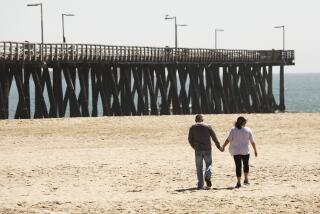Chain of Failures Cited in South Bay Sewage Spill
- Share via
All four safeguards designed to prevent a major sewage spill failed this month at a Manhattan Beach pumping station, leading to a huge leak into the ocean, according to a preliminary investigation to be released today.
Officials probing the causes of the Jan. 15 sewage spill -- the largest to hit Santa Monica Bay in a decade -- have until now focused on a general failure of an electrical system that prevented motors from running at the pumping station.
But the investigation, by the Sanitation Districts of Los Angeles County, found a much larger system failure that raises questions about how well pumping stations across the region operate. Moreover, officials are still trying to figure out why some of the systems broke down all at once.
The report will be delivered to the Los Angeles County Board of Supervisors, which has demanded an explanation of the accident.
“We always learn something new and important from unusual events like this,” said Joe Haworth, with the county sanitation district. “Most of the time all 550 million gallons of sewage that we pump each day stays in the sewer, so it took a lot of independent circumstances to conspire to make the system go awry.”
The preliminary report found four separate failures at the pumping station:
* A series of electrical snafus caused the station to shut down and sewage to back up.
* An emergency backup electrical system that was supposed to turn on in the event of a power outage failed to activate.
* An alarm system designed to immediately alert headquarters personnel of the problem didn’t work, delaying the response to the spill.
* A separate system designed to measure the depth and pressure inside the pumping station also didn’t work. That system is supposed to detect the possible overflow of sewage and activate pumps to prevent a spill from occurring.
Those problems conspired to cause a massive overflow of raw sewage out of manhole covers, onto the sand and into the ocean in Hermosa Beach and Manhattan Beach.
Crews contained most of the estimated 1.7 million gallons to an area the size of a football field near the Manhattan Beach Strand at 21st Street.
As much as 100,000 gallons of sewage tinged with flecks of toilet paper and other effluent flowed into Santa Monica Bay. Sewer water and muck also backed up into four homes in Hermosa Beach.
The incident evoked anger from South Bay residents, city officials and environmentalists, as well as county supervisors. The board ordered county sanitation officials to produce a detailed report on the spill’s cause and to outline measures to head off future spills.
Some environmentalists have called on officials to retrofit all pumping stations with underground storage facilities to capture leaking sewage that would otherwise flow into streets, flood-control channels, the beach and the ocean. But sanitation district officials say such structures would be hugely expensive.
The sanitation district had begun upgrades of aging -- and less versatile -- equipment, specifically the electrical control panels at the Manhattan Beach pumping station, the report said. Work had also begun as part of a larger effort to upgrade 54 stations with more modern technology, including allowing workers in Long Beach to automatically control the pumping of sewage.
More to Read
Sign up for Essential California
The most important California stories and recommendations in your inbox every morning.
You may occasionally receive promotional content from the Los Angeles Times.










